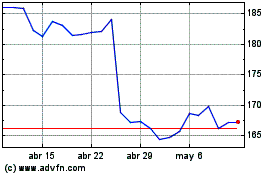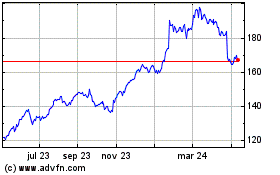IBM's Revenue Falls Again -- Update
16 Abril 2019 - 3:57PM
Noticias Dow Jones
By Asa Fitch
International Business Machines Corp. reported a
third-consecutive quarter of declining revenue Tuesday, further
clouding Chief Executive Ginni Rometty's yearslong quest to
revitalize the computing giant.
Under Ms. Rometty, who has been at the helm since 2012, IBM has
poured resources into its cloud-computing business and new
technologies such as artificial intelligence, aiming to reorient
Big Blue in a world where traditional growth engines like equipment
sales and services haven't been growing as fast as they once did.
IBM said its cloud businesses grew 10% in the past 12 months.
For a brief spell last year, it appeared as though IBM had
turned a corner, reporting successive quarters of overall revenue
growth -- however small.
That changed in the middle of 2018, as Wall Street analysts and
investors watched revenue tip back under. It fell again in the
first quarter, dropping 4.7% to $18.18 billion. Analysts had
expected $18.46 billion, according to Refinitiv.
IBM's software and technology services, which include computing
infrastructure and IT support services, drove the decline. IBM had
faced a tough comparison to last year's first quarter, when a new
generation of industrial-strength mainframe computers helped drive
sales.
Net income fell 5.2% to $1.59 billion. Adjusted profit, which
excludes some items such as acquisition costs, came to $2.25 a
share. Analysts had expected $2.22.
Despite the drop in net profit and revenue, IBM touted the
growth in its cloud-computing revenue, which reached $19.5 billion
for the past 12 months. Chief Financial Officer James Kavanagh also
pointed to IBM's expanding margins as the company pursues
faster-growing businesses that cost less to run.
While growth was flat or declined in all of IBM's main reported
lines of business, the company bumped up its overall profit margin
by a percentage point to 44.2%.
Once an icon of American ingenuity, IBM has struggled to compete
in the modern computing era as the rise of cloud giants like
Amazon.com Inc. and Alphabet Inc.'s Google have challenged an old
model where big companies handled their critical computing needs
largely in-house. IBM sees promise in the so-called hybrid cloud --
the idea that companies will increasingly use a combination of
cloud services and their own equipment to accomplish those tasks --
and aims to grow that business.
IBM's cloud segment may not be growing as fast as some of Amazon
or Microsoft's cloud services, Mr. Kavanagh said, but the company
is keeping pace with its target for mid-teen growth in the hybrid
cloud, a rate he said can allow it to take share in that arena.
Ms. Rometty is aiming to bolster IBM's hybrid-cloud strategy
through IBM's acquisition of Red Hat Inc., an open-source software
and services company that helps businesses streamline their
computing strategies as they grow. That deal, valued at around $33
billion, is IBM's largest-ever acquisition and is expected to close
in the second half of the year.
IBM's revenue had fallen virtually every quarter since Ms.
Rometty took over, up until the last quarter of 2017, when it
suddenly rose again. The company saw further revenue rises in the
first half of last year, but that turnaround proved short-lived:
Revenue declined again in the last two quarters of 2018.
Write to Asa Fitch at asa.fitch@wsj.com
(END) Dow Jones Newswires
April 16, 2019 16:42 ET (20:42 GMT)
Copyright (c) 2019 Dow Jones & Company, Inc.
International Business M... (NYSE:IBM)
Gráfica de Acción Histórica
De Mar 2024 a Abr 2024

International Business M... (NYSE:IBM)
Gráfica de Acción Histórica
De Abr 2023 a Abr 2024
